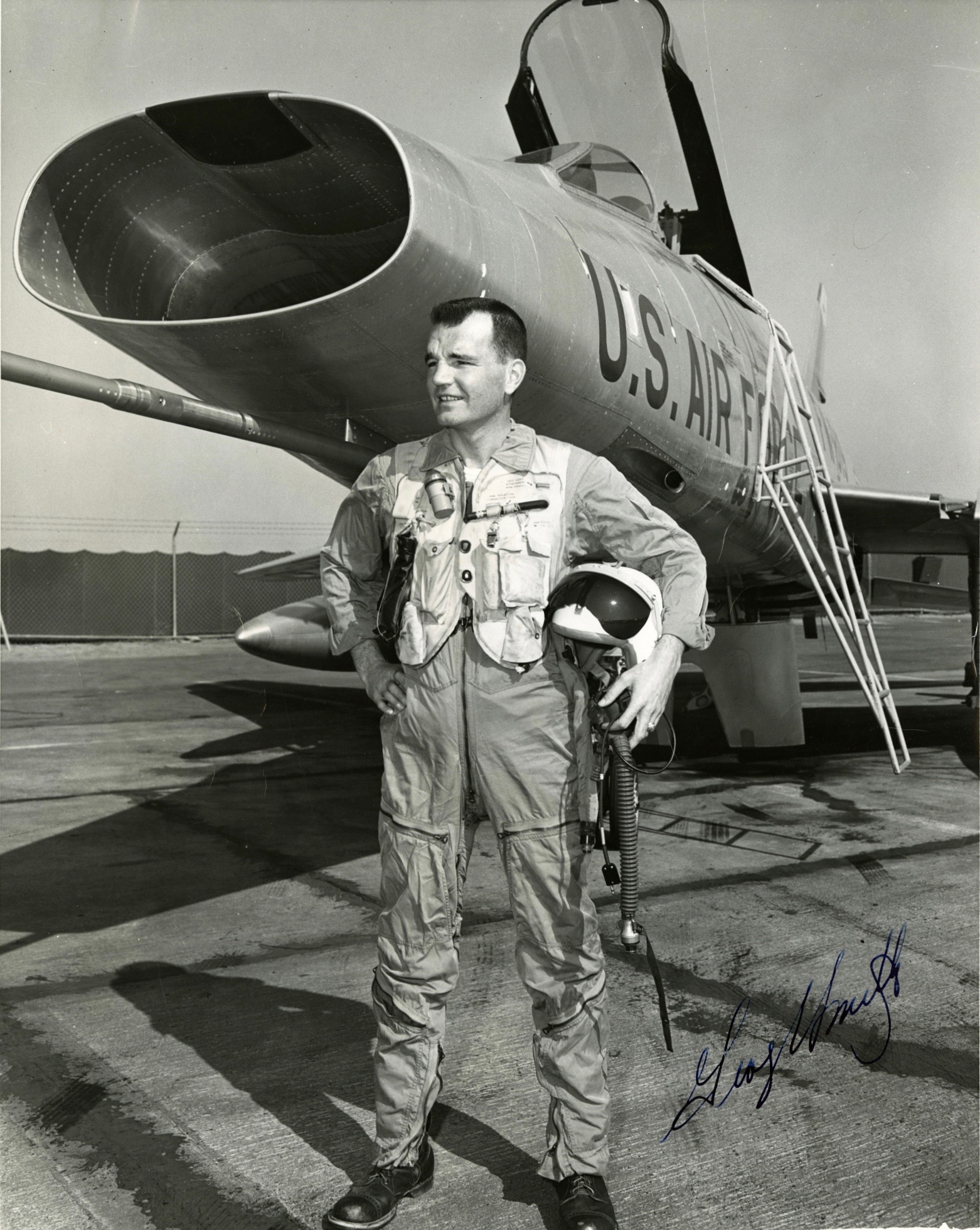
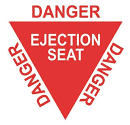 26 February 1955: Although it was his day off, North American Aviation production test pilot George Franklin Smith stopped by the office at Los Angeles Airport (today, known as Los Angeles International airport, or simply “LAX”, its international airport identifier). The company’s flight dispatcher told him that a brand-new F-100A-20-NA Super Sabre, serial number 53-1659, was sitting on the flight line and needed to be test flown before being turned over to the Air Force.
26 February 1955: Although it was his day off, North American Aviation production test pilot George Franklin Smith stopped by the office at Los Angeles Airport (today, known as Los Angeles International airport, or simply “LAX”, its international airport identifier). The company’s flight dispatcher told him that a brand-new F-100A-20-NA Super Sabre, serial number 53-1659, was sitting on the flight line and needed to be test flown before being turned over to the Air Force.
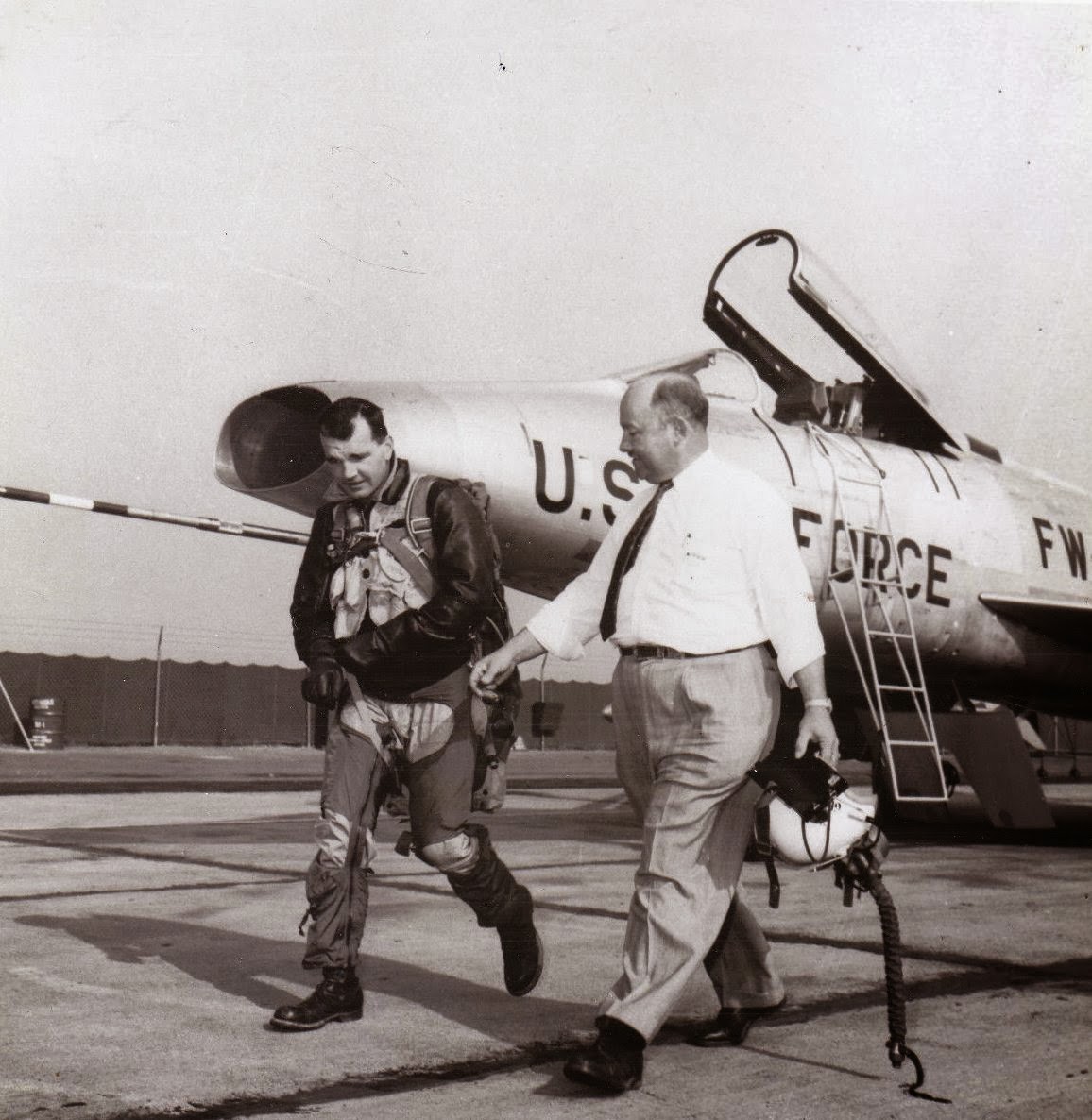
Smith was happy to take the flight. He departed LAX in full afterburner and headed off shore, climbing to 35,000 feet (10,668 meters) over the Pacific Ocean to start the test sequence.
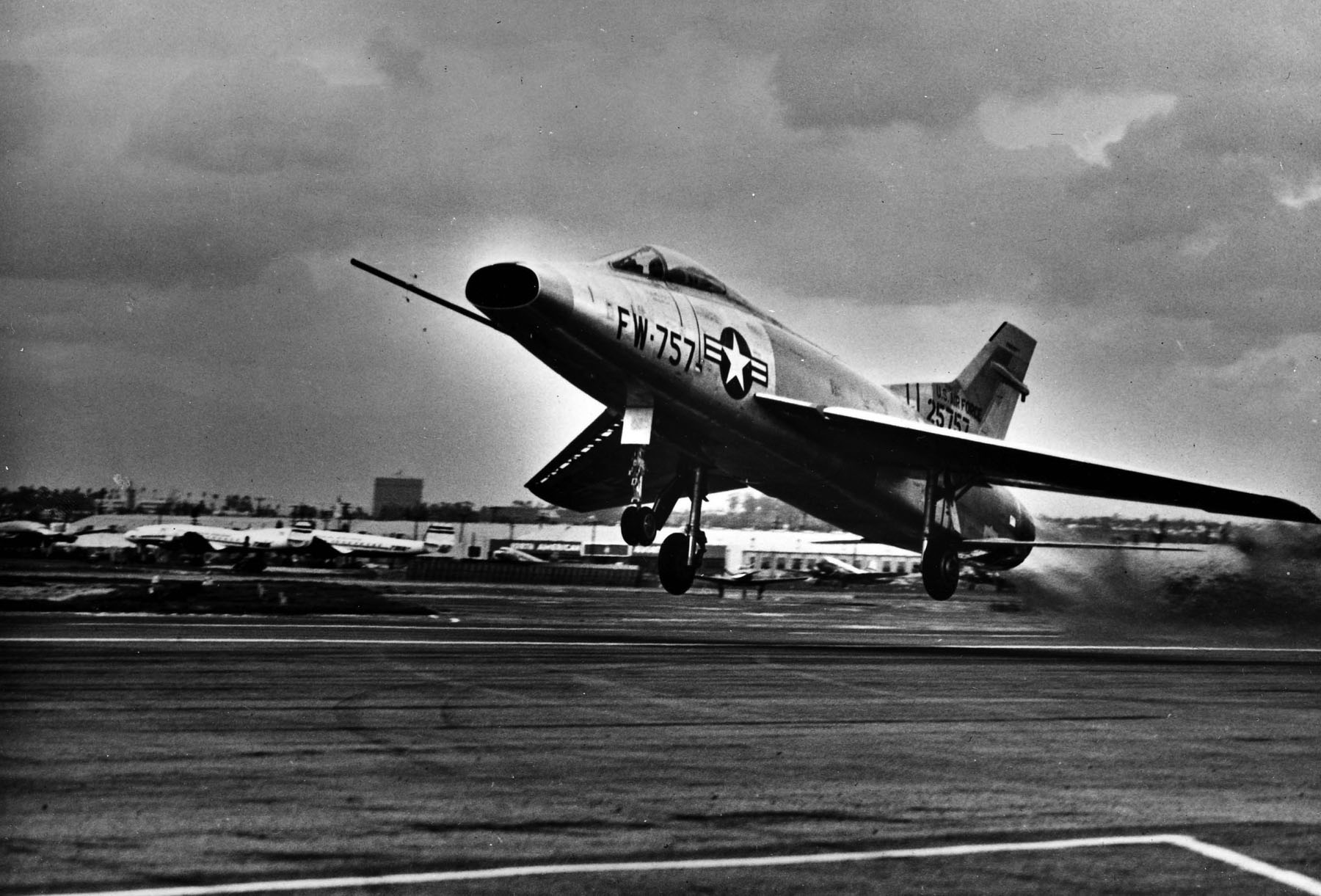
But it was quickly apparent that something was wrong: The flight controls were heavy, and then there was a hydraulic system failure that caused the Super Sabre pitch down into a dive. Smith couldn’t pull it out of the dive and the airplane’s speed rapidly increased, eventually passing Mach 1.
Smith was unable to regain control of the F-100. He had no choice but to bail out. As he ejected, Smith read the instruments: the Mach meter indicated Mach 1.05—785 miles per hour (1,263 kilometers per hour)—and the altitude was only 6,500 feet (1,981 meters).
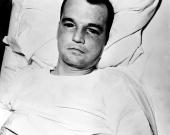
The force of the wind blast hitting him as he came out of the cockpit knocked him unconscious. Estimates are that he was subjected to a 40 G deceleration. His parachute opened automatically and he came down approximately one-half mile off Laguna Beach. Fortunately he hit the water very close to a fishing boat crewed by a former U.S. Navy rescue expert.
The F-100 dived into the Pacific Ocean approximately ¼-mile (0.4 kilometers) offshore between Dana Point and Laguna Beach.
George Smith was unconscious for six days, and when he awoke he was blind in both eyes. After four surgeries and seven months in the hospital, he recovered from his supersonic ejection and returned to flight status.
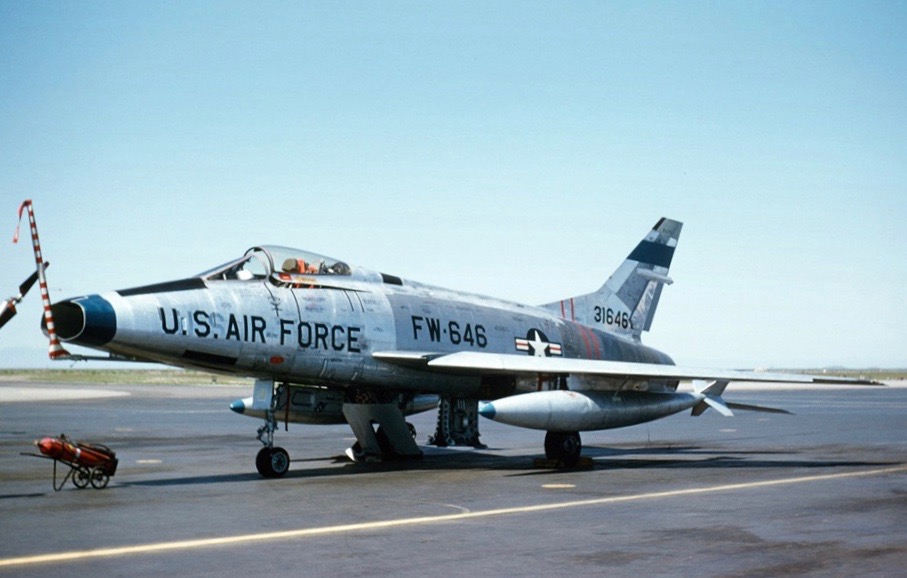
George F. Smith appears in this brief U.S. Air Force informational film:
 The North American Aviation F-100 Super Sabre was designed as a supersonic day fighter. Initially intended as an improved F-86D and F-86E, it soon developed into an almost completely new airplane. The fuselage incorporated the “area rule,” a narrowing in the fuselage width at the wings to increase transonic performance, similar to the Convair F-102A.
The North American Aviation F-100 Super Sabre was designed as a supersonic day fighter. Initially intended as an improved F-86D and F-86E, it soon developed into an almost completely new airplane. The fuselage incorporated the “area rule,” a narrowing in the fuselage width at the wings to increase transonic performance, similar to the Convair F-102A.
The Super Sabre had a 49° 2′ sweep to the leading edges of the wings and horizontal stabilizer. The ailerons were placed inboard on the wings and there were no flaps, resulting in a high stall speed in landing configuration. The horizontal stabilizer was moved to the bottom of the fuselage to keep it out of the turbulence created by the wings at high angles of attack. The F-100A had longer wings and a distinctively shorter vertical fin than the YF-100A. The upper segment of the vertical fin was swept 49° 43′.
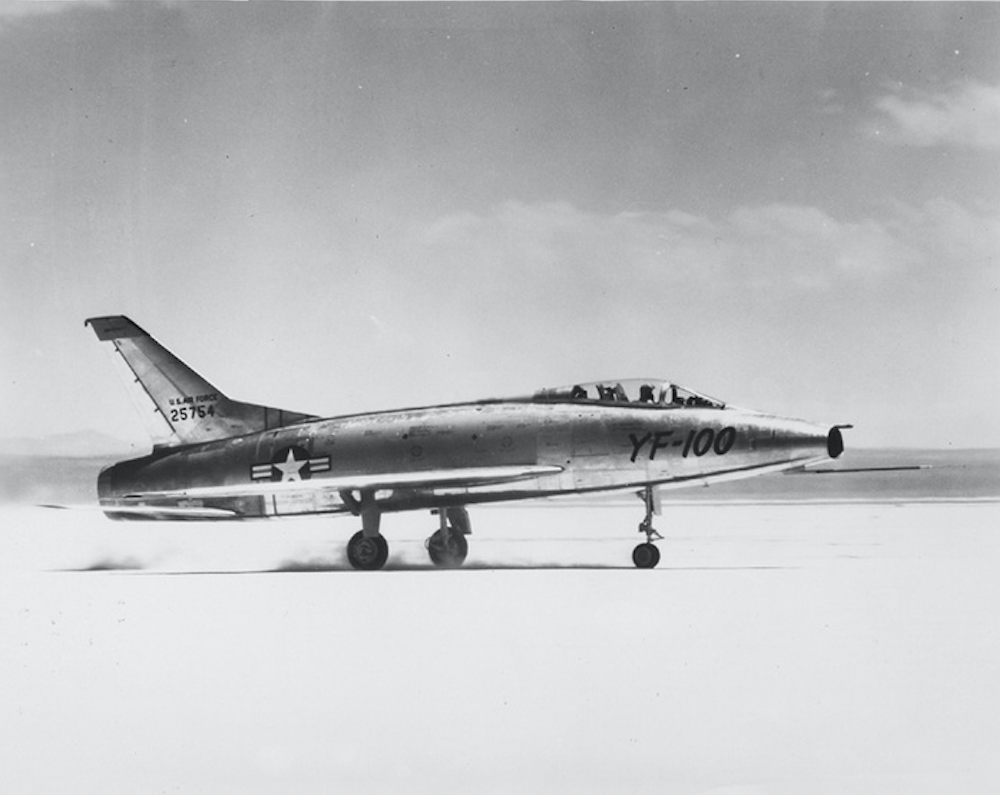
There were two service test prototypes, designated YF-100A, followed by the production F-100A series. The first ten production aircraft (all of the Block 1 variants) were used in the flight testing program.
The F-100A Super Sabre was 47 feet, 1¼ inches (14.357 meters) long with a wingspan of 36 feet, 6 inches (11.125 meters). With the shorter vertical fin than the YF-100A, the initial F-100As had an overall height of 13 feet, 4 inches (4.064 meters), 11 inches (27.9 centimeters) less than the YF-100A.
The F-100A had an empty weight of 18,135 pounds (8,226 kilograms), and gross weight of 28,899 pounds (13,108 kilograms). Maximum takeoff weight was 35,600 pounds (16,148 kilograms). It had an internal fuel capacity of 755 gallons (2,858 liters) and could carry two 275 gallon (1,041 liter) external fuel tanks.
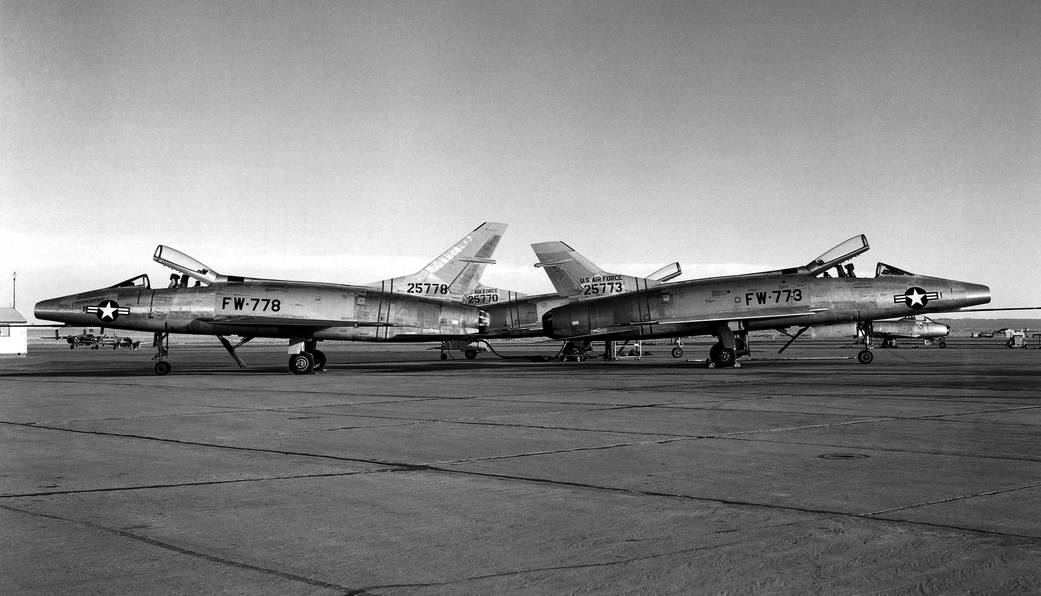
 The early F-100As were powered by a Pratt & Whitney Turbo Wasp J57-P-7 afterburning turbojet engine. It was rated at 9,700 pounds of thrust (43.148 kilonewtons) for takeoff, and 14,800 pounds (65.834 kilonewtons) with afterburner. Later production aircraft used a J57-P-39 engine. The J57 was a two-spool axial flow turbojet which had a 16-stage compressor, and a 3-stage turbine. (Both had high- and low-pressure stages.) The engine was 15 feet, 3.5 inches (4.661 meters) long, 3 feet, 5.0 inches (1.041 meters) in diameter, and weighed 4,390 pounds (1,991 kilograms).
The early F-100As were powered by a Pratt & Whitney Turbo Wasp J57-P-7 afterburning turbojet engine. It was rated at 9,700 pounds of thrust (43.148 kilonewtons) for takeoff, and 14,800 pounds (65.834 kilonewtons) with afterburner. Later production aircraft used a J57-P-39 engine. The J57 was a two-spool axial flow turbojet which had a 16-stage compressor, and a 3-stage turbine. (Both had high- and low-pressure stages.) The engine was 15 feet, 3.5 inches (4.661 meters) long, 3 feet, 5.0 inches (1.041 meters) in diameter, and weighed 4,390 pounds (1,991 kilograms).
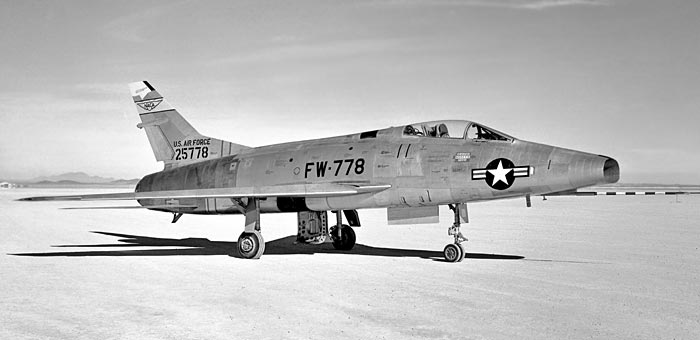
The Super Sabre was the first U.S. Air Force fighter capable of supersonic speed in level flight. It could reach 760 miles per hour (1,223 kilometers) at Sea Level. (Mach 1 is 761.1 miles per hour, 1,224.9 kilometers per hour, under standard atmospheric conditions.) Its maximum speed was 852 miles per hour (1,371 kilometers per hour) at 35,000 feet (10,668 meters). The service ceiling was 44,900 feet (13,686 meters). Maximum range with external fuel was 1,489 miles (2,396 kilometers).
The F-100 was armed with four M-39 20 mm autocannons, capable of firing at a rate of 1,500 rounds per minute. The ammunition capacity of the F-100 was 200 rounds per gun.
North American Aviation built 199 F-100A Super Sabres at its Inglewood, California, plant before production shifted to the F-100C fighter bomber variant. Approximately 25% of all F-100As were lost in accidents.
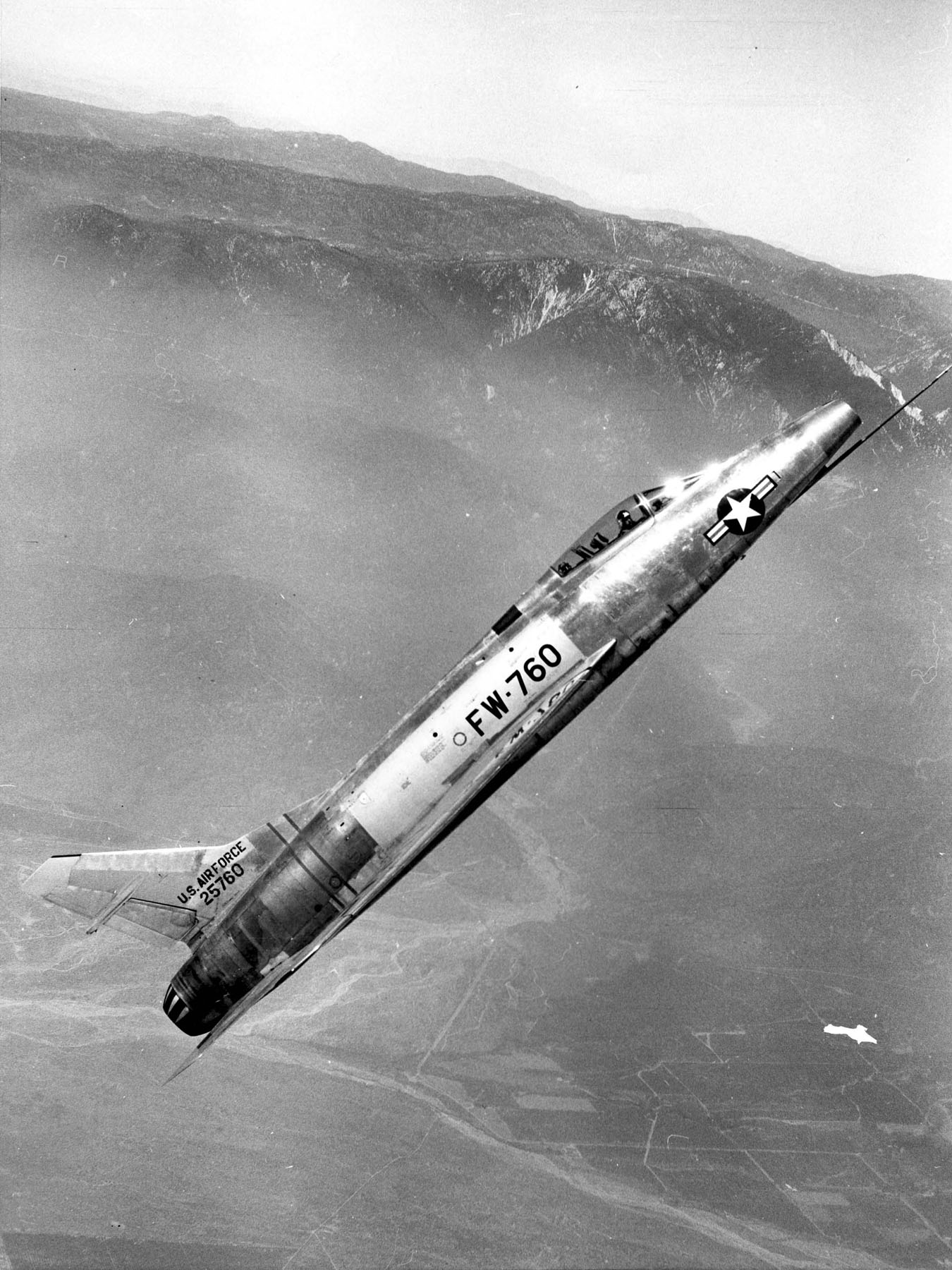
© 2019, Bryan R. Swopes
Thanks for posting. Great look at a super plane. (Glad you didn’t have any of these problems)
Thank you, Peggy.
I flew 132 combat missions in the F-100D in Vietnam, 1970-1971. Those four 20mm cannons were great! I only went supersonic once, on a training mission. They did so much work making it supersonic capable, but its real mission was to carry bombs. It was our primary fighter for close air support in Vietnam, and is often seen flying low to drop napalm only a hundred meters from our ground troops.
It would have carried bombs better if the wing wasn’t swept back so sharply. The sharp sweep made it more difficult to control at low speeds. It had a long takeoff roll when loaded. We called it “the world’s fastest tricycle” because it landed at high speed and was very hard to stop!
I have several videos of my F-100 missions on Facebook / Spirit of Attack. Look at my videos, especially “The Battle of Prey Torteng#1”, “Battle of Prey Torteng#2”, “Night Weather in Vietnam”.
Thanks, Bruce. Great information!
When I started reading, I thought this was going to be about the “Sabre Dance” incident. Kudos to Mr. Smith for having the presence of mind and good luck to survive! Did the F-100 have one of the higher accident rates compared to other USAF fighters? 1 in 4 seems rather high!
Hi, Marc:
For the Sabre Dance, see:
https://www.thisdayinaviation.com/10-january-1956/
No, not really. But “flying jets” was a dangerous occupation in those days. (It still is.) The raw figure doesn’t tell us what the pilot was doing when the accident occurred, e.g., air-to-ground gunnery, low-level flight, etc. A small problem can flare way out of proportion at high speeds and low altitudes.
In West German service, the Lockheed F-104 was known as the Witwenmacher (“Widowmaker”). Of 915 airplanes, 270 (29%) were lost in accidents. This was a much higher rate than that of F-104s flown in the United States, but flying a Mach 2 airplane at low altitude in lousy weather while training for NATO nuclear strike missions was an entirely different thing than high altitude interceptions in the clear skies over North America.
In contrast, 40% of the the Republic F-105 fleet (334 of 833 airplanes) were lost in combat in Southeast Asia. But a large number were lost back in the U.S. during training flights.
So, no, I don’t think that any of these airplanes were “accident prone.” It was a dangerous business.
Thanks. —Bryan
Thank you for this! We also had F-100 Fast Facs in Vietnam.
Unfortunately, the F-100 did have the highest accident rate of all fighters in its time of over 38%, killing 324 pilots. The aircraft had some inherent flight characteristics at low speeds which required unorthodox use of flight controls. At 200 Kts or below, the plane became strictly a rudder only plane for turning and rolling. You also had to anticipate power requirements to avoid getting behind the power curve. In spite of these idiosyncrasies, with proper pilot training, the airplane was a good work horse for the tactical forces and flew 360,283 combat sorties, more than any other fighter. What I liked about the F-100 was once you mastered it, it made you a better pilot capable of flying any thing.
Thank you, Victor.
You have to experience ADVERSE YAW in the F-100 to appreciate it! Other planes have very little adverse yaw, but in the F-100 it could water your eyes and was partly responsible for the infamous “SABRE DANCE”. Adverse yaw occurs if you use aileron to roll while pulling Gs (high angle of attack) on the airplane.
I came off of a bombing attack in Vietnam in an F-100D, 1971. I saw my flight lead below and to the right of me — I wanted to join on him for the routine battle damage check for holes in our planes. He had set up a gentle left turn to make my rejoin easy.
I was feeling good. He was below me, so I dove gently toward him, intending to join on his right wing, outside the turn. As I got close to his right wing, I pulled back on the stick and gave a little left aileron to come zipping into position on his right wing.
ADVERSE YAW! Gs and left aileron — the F-100 snapped to the RIGHT, inverted! I realized what had happened, completed a complete roll (using rudder) and came up nicely on his LEFT wing!
To an outside observer, It probably would look like a snazzy join-up — diving down, doing a quick barrel roll to the right, and pulling up on lead’s left wing. The problem was that I didn’t plan it that way, and I learned a quick lesson on the F-100 and ADVERSE YAW.
See my Facebook/Spirit of Attack or YouTube Spirit of Attack / Rudder Reversal for videos of another fancy move that I tried in the F-100 that nearly killed me.
Thanks for that explanation, Bruce.
In 1956? Í was working at Keflavík Airport ( Icelandic Gov. job) . I borrowed a truck
And me and a friend went to the runway to watch flights of F-100’s landing and
Saw 2 of them collide on very short final, one slamming to the ground and the other
Land far up the runway. The one that hit the ground about 30. feet short of the
Runway, shearing off the landing gear, going past us on the belly and left the runway
About 1500 feet from us, and reared up on the nose and fell down, a small
Explosion occurred and a small fire lasting about 2 minutes.
The base commander was close to the end of the runway and raced after the jet,
Rescuing the pilot, which was severely injured including broken spine. He was
Flown to England by the base C-54. I filmed this with my 8 mm movie camera from
Touchdown till it stopped. I have on film the main gear coming at me , my friend
Was screaming at me about the right gear heading straight at me , but I could
See the gear coming at me through the view finder and it stopped about 10 feet
From me. I went out of curiosity and felt the shear point on the leg and burned
My finger! I showed the film to the accident investigator later.
The F100 and the F8 (that I flew) had the same engine, but the F8 was 3,000 lbs lighter than the 100. At the bar at Buckley ANGB following air to air tactical engagements, one Super Sabre pilot told me: “When you guys light the burner in the F8, you actually accelerate. When we light the burner, the only thing that happens is the noise level increases.”
The F100 was a beautiful airplane and great bombers in Vietnam.
As I remember, the F100D was modified to improve the handling, the wing trailing edge was “cranked” inboard, changing the wing shape.